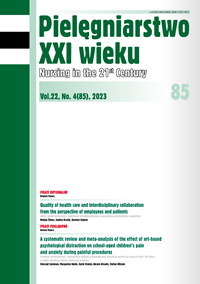Proces pielęgnacji pooperacyjnej pacjentki w ciąży z oponiakiem: opis przypadku
DOI:
https://doi.org/10.2478/pielxxiw-2023-0035Słowa kluczowe:
proces pielęgnowania, neurochirurgia, okres pooperacyjny, model funkcjonalnych wzorców zdrowia Gordona, NANDA-IAbstrakt
PROCES PIELĘGNACJI POOPERACYJNEJ PACJENTKI W CIĄŻY Z OPONIAKIEM: OPIS PRZYPADKU
Cel pracy. Celem pracy jest ocena przypadku, w którym zdiagnozowano oponiaka w czasie ciąży oraz przedstawienie zindywidualizowanego procesu pielęgnowania pooperacyjnego.
Materiał i metody. Do oceny przypadku wykorzystano Model Funkcjonalnych Wzorców Zdrowia Gordona. Proces pielęgnowania został opracowany przy wykorzystaniu diagnoz pielęgniarskich North American Nursing Diagnosis Association-International, Taxonomy II.
Wyniki. W procesie pielęgnowania w tym przypadku uwzględniono diagnozy pielęgniarskie w obszarach postrzegania zdrowia/wzorca zarządzania zdrowiem, wzorca odżywiania/metabolizmu, wzorca eliminacji, wzorca aktywności/ćwiczeń, wzorca snu/odpoczynku, wzorca poznawczego/percepcji, samooceny/wzorca samoświadomości, wzorca ról/relacji, wzorca radzenia sobie/tolerancji na stres, wzorca seksualności/reprodukcyjności oraz wzorca wartości/przekonań. Na podstawie tych diagnoz ustalono proces pielęgnowania.
Wnioski. W tym opisie przypadku chcielibyśmy podkreślić znaczenie wykorzystania modelu funkcjonalnych wzorców zdrowia Gordona do oceny ciężarnej pacjentki z oponiakiem i planowania procesu pielęgnowania pooperacyjnego. Uważa się, że opis przypadku będzie przewodnikiem i wsparciem dla pielęgniarek opiekujących się ciężarnymi pacjentkami chorymi na oponiaka.
Bibliografia
1. Fathi AR, Roelcke U. Meningioma. Curr. Neurol. Neurosci. Rep. 2013; 13(4): 337.
2. Dumitrescu BC, Tataranu LG, Gorgan MR. Pregnant woman with an intracranial meningioma – case report and review of the literature. Rom. Neurosurg. 2015; 21(4): 489-496.
3. Bohan E, Glass-Macenka D. It’s not your “run of the mill” meningioma: Characteristics differentiating low-grade from high-grade meningeal tumors. J. Neurosci. Nurs. 2009; 41(3): 124-128.
4. Dallaire C, Dallaire M, Juneau L, et al. Réussir une saine transition vers le domicile suite à une résection d’un méningiome: l’effet d’interventions infirmières. Can. J. Neurosci. Nurs. 2016; 38(1): 65-74.
5. Schepers VPM, Van Der Vossen S, Berkelbach Van Der Sprenkel JW, et al. Participation restrictions in patients after surgery for cerebral meningioma. J. Rehabil. Med. 2018; 50(10): 879-885.
6. Özbayir T, Malak AT, Bektas M, et al. Information needs of patients with meningiomas. Asian Pacific J. Cancer Prev. 2011; 12(2): 439-441.
7. Hortobágyi T, Bencze J, Murnyák B, et al. Pathophysiology of meningioma growth in pregnancy. Open Med. 2017; 12(1): 195-200.
8. Lusis EA, Scheithauer BW, Yachnis AT, et al. Meningiomas in pregnancy: A clinicopathologic study of 17 cases. Neurosurgery. 2012; 71(5): 951-961.
9. Kanaan I, Jallu A, Kanaan H. Management strategy for meningioma in pregnancy: A clinical study. Skull Base. 2003; 13(4): 197-202.
10. de Magalhães KCSF, Vaz JPM, Gontijo PAM, et al. Profi le of patients with brain tumors and the role of nursing care. Rev. Bras. Enferm. 2016; 69(1): 138-143.
11. Türen S, Enç N. A comparison of Gordon’s functional health patterns model and standard nursing care in symptomatic heart failure patients: A randomized controlled trial. Appl. Nurs. Res. 2020; 53: 151247.
12. Carpenito LJ. Nursing Diagnosis: Application to Clinical Practice. 14 th. Lippincott Williams & Wilkins; 2012.
13. Ackley BJ, Ladwig GB, Makic MBF. Nursing Diagnosis Handbook, 11th Edition. Elsevier Mosby; 2017. https://evolve.elsevier.com/cs/product/9780323322249?role=student
14. Clement I. Nursing diagnosis. In: Textbook on Professional Trends and Adjustments in Nursing. Jaypee Brothers Medical Publishers (P) Ltd.; 2016.
15. Arlıer S. Primary intracranial tumor in the pregnancy; menengioma. Bozok Med. J. 2017; 7(1): 96-99.
16. Siegel C, Armstrong TS. Nursing guide to management of major symptoms in patients with malignant glioma. Semin. Oncol. Nurs. 2018; 34(5): 513-527.
17. Yılmaz İ, Özden D, Gürol Arslan G. An analysis of an intensive care unit patient with tracheostomy according to the Omaha Classifi cation System. Turkiye Klin. J. Nurs. Sci. 2018; 10(2): 160-168.
18. Baksi Şimşek A, Dicle A. Nursing model and care: Evaluation with the Roy Adaptation Model of patients with primary brain tumor. J. Educ. Res. Nurs. 2015; 12(3): 224-232.
19. Temel M, Kutlu FY. Functional Health Pattern Model based care plan for a depression diagnosed patient. Florence Nightingale J. Nurs. 2019; 27(1): 91-103.
20. Simsek A, Dicle A. Primer beyin tümörü: Klinik özellikler, tedavi ve bakım. E-Journal Dokuz Eylul Univ. Nurs. Fac. 2013; 6(2): 102-113.
21. Nassiri F, Price B, Shehab A, et al. Life after surgical resection of a meningioma: A prospective cross-sectional study evaluating health-related quality of life. Neuro. Oncol. 2019; 21: I32-I43.
22. Altun Uğraş G, Kanat C. Could nursing interventions cause secondary brain insult? Acıbadem Univ. Heal. Sci. J. 2019; 10(1): 13-19.
23. Varghese R, Chakrabarty J, Menon G. Nursing management of adults with severe traumatic brain ınjury: A narrative review. Indian J. Crit. Care Med. 2017; 21(10): 684-697.
24. Gondar R, Patet G, Schaller K, et al. Meningiomas and cognitive impairment after treatment: A systematic and narrative review. Cancers (Basel). 2021; 13(8): 1-11.
25. Zamanipoor Najafabadi AH, Peeters MCM, Dirven L, et al. Impaired health-related quality of life in meningioma patients - A systematic review. Neuro. Oncol. 2017; 19(7): 897-907.
26. Şahin G, Akyüz E. Nursing care of patients with deep vein thrombosis according to Gordon’s Functional Health Patterns Model: Case report. J. Cardiovasc. Nurs. 2018; 9(18): 35-40.
27. Llewellyn H, Neerkin J, Thorne L, et al. Social and structural conditions for the avoidance of advance care planning in neuro-oncology: a qualitative study. BMJ Open. 2018; 8(1): e019057.
28. Piil K, Juhler M, Jakobsen J, et al. Daily life experiences of patients with a high-grade glioma and their caregivers. J. Neurosci. Nurs. 2015; 47(5): 271-284.
29. Schubart JR, Kinzie MB, Farace E. Caring for the brain tumor patient: Family caregiver burden and unmet needs. Neuro. Oncol. 2008; 10(1): 61-72.
Pobrania
Opublikowane
Numer
Dział
Licencja
Prawa autorskie (c) 2023 Autorzy

Utwór dostępny jest na licencji Creative Commons Uznanie autorstwa 4.0 Międzynarodowe.




